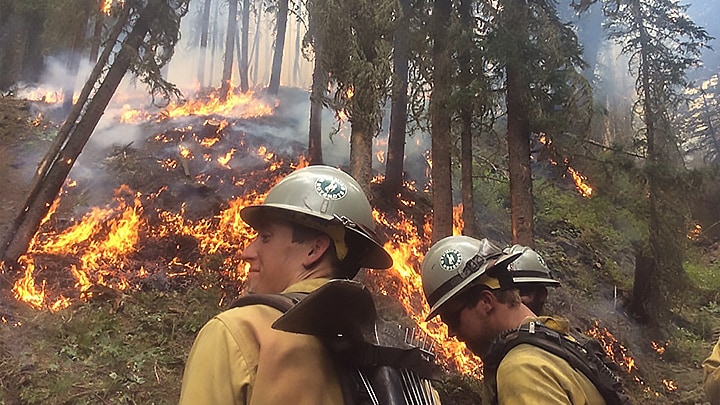At a glance
More than 400 on-duty wildland firefighting fatalities occurred in the United States from 2000-2019. Wildland firefighters are exposed to biological, chemical, ergonomic, physical, psychosocial, and safety hazards. NIOSH offers resources to help prevent on-duty injuries, illnesses, and deaths from hazards and exposures associated with fighting wildland fires.
Overview

Every year, millions of acres of land burn across the United States and wildland firefighters (WFFs) are asked to protect our lives, homes, and forests. But wildland fires are unpredictable and dangerous. More than 400 on-duty WFF fatalities occurred between 2000-2019, based on data compiled in the NIOSH Wildland Firefighter On-Duty Death Surveillance System from three data sources.123 Common hazards faced on the fire line can include burnovers/entrapments, chemical exposures, heat-related illnesses and injuries, smoke and dust inhalation, vehicle-related injuries (including aircraft), slips, trips, and falls, loud noise exposure, and falling debris.4 In addition, because of prolonged intense physical exertion, WFFs are at risk for sudden cardiac deaths and rhabdomyolysis (overexertion leading to muscle tissue damage).
NIOSH offers resources for fire departments, firefighters, and partner organizations to prevent on-duty injuries, illnesses, and deaths from hazards and exposures associated with fighting wildland fires.
NIOSH is actively recruiting wildland firefighters to join the National Firefighting Registry for Cancer.
CDC and NIOSH also provide resources for workers regarding hazards they encounter when cleaning up after a wildland fire.
NIOSH information on hazards related to structure fires can be found on the Structure Fires page.
Resources and Publications
Exposures to Occupational Hazards and Health Effects
Wildland Firefighter Fatalities
Rhabdomyolysis
Firefighter resources for rhabdomyolysis.
Hearing Loss
Hearing loss resources for firefighters.
Additional Resources
Other Wildland Firefighting Information
Federal and non-federal wildland firefighting agencies provide resources for wildland firefighters.
Federal Resources
Non-federal Resources
- Federal Emergency Management Agency, Fire Administration (US). [2017] Fire Fighter Fatalities in the United States. Date accessed: January, 2017.
- National Wildfire Coordinating Group, Risk Management Committee. [2017] Safety Gram Archive. Date Accessed January, 2017.
- National Fire Protection Association (US). [2017] Fatalities and Injuries. Date accessed: January, 2017.
- Britton C, et al., Epidemiology of injuries to wildland firefighters. Am J Emerg Med. 2013 Feb; 31(2):339-45. [Epub 2012 Nov 15].
